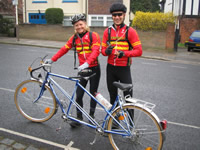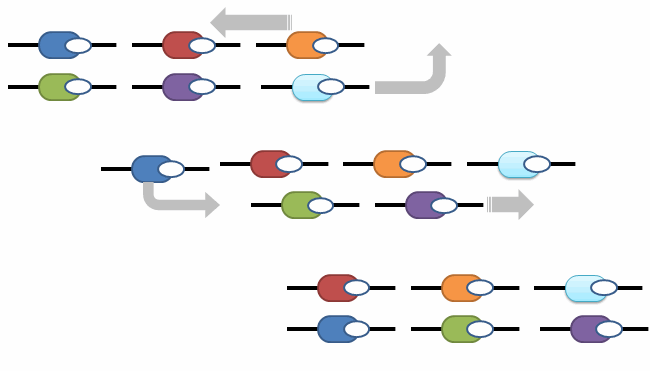Group Riding Skills
 |
| Michael and Emmie on a tandem wrapped up for winter riding. It may be sociable, but is it safe or steady to let Emmie on the front? |
Group riding is about being able to ride in a pack in close formation comfortably and safely. Even though triathletes don’t race in packs, you need to develop these skills for two reasons:
The first is safety - a group of 8 people riding with a gap of one meter in single file is roughly 25m long! This encourages impatient drivers to pass too close to the group. Two abreast with a gap of 50cm is almost a third of the length and being a little wider forces drivers to wait until the road is wide enough to pass safely.
The second reason is to help the group stay together for a more sociable ride. We aren’t all of the same ability but drafting behind other riders can save as much as 40% of the power needed to maintain a given speed. If you are hanging off the back because you lack group riding confidence then you are working much harder and may get dropped.
It is difficult to learn how to ride in a group from a web page. This is why we have introductory rides. This type of practice is useful for riders of all fitness levels not just people who are new to riding but here we'll establish some rules that we all stick to.
Group size
Keep groups at 6 to 8 people. Peletons spread out along the road are a nightmare for a car to pass, leading to drivers taking undue risks with your life! When groups exceed 8 on twisty turny country roads it becomes more difficult to maintain a tight group formation and riders get dropped without the leader being aware. Respect the group size and you will have a more enjoyable and productive ride.
Close formation riding
Riding on level ground your front wheel should be within 50cm of the back wheel of the bike in front. This takes practice to get comfortable with. You should also be close enough to touch the rider next to you. By riding in close formation it makes the group easier to overtake and increases the draft benefit for the weaker riders in the group.
On downhills you may prefer to leave a bigger gap to the bike in front and when going uphill beware of standing out of the saddle and pushing your bike backwards into the rider behind.
Ride in order to keep the group together. If you are on the front, don't accelerate hard out of junctions or over the tops of hills because you'll stretch out the group like a rubber band and the effort to close gaps will slowly exhaust the weaker riders. If you are in the pack, close the gaps quickly when they open. This may mean having to work hard for a short period – this is how you pay back those doing the hard work up front! Do not be offended when another rider tells you to close a gap, and if you don't feel able to do so then tell others so they can move up into your place.
DON'T use tri bars – they are for riding alone, not for drafting in a group.
DON'T overlap wheels – riders should follow the wheel in front but not let their front wheel overlap the back wheel of the rider in front, it is the most common cause of a crash in a group.
DON'T make sudden movements – braking suddenly or altering your course unannounced will create havoc for the riders behind you.
Communication and warnings
In a group you can't see the road ahead so it is essential that the riders at the front and back announce hazards and those announcements are passed through the rest of the group. You'll hear the following shouts:
HOLE! Indicate holes, gratings, rocks and other obstructions by pointing or shouting a warning.
STOPPING! or SLOWING! The group has to get warning about changes in pace.May also be indicated by a hand being held up by those on the front.
CLEAR! At junctions, riders ahead of you will often warn of approaching cars. Don't take the word of a tired cyclist though and check for yourself.
CAR BACK! or CAR UP! On narrow roads this warns the group to keep in close formation or even to move into single file if necessary.
EASE UP! A rider with fresh legs hits the front and the injection of pace starts to blow the group apart. Ease up is a message for him to cool it.
All these warnings and others that you will hear must be passed backwards or forwards in the group so that all are aware of the hazards and problems.
Other essential rules & skills
You have to be able to take one hand off the bars to drink, to signal and to look at the road behind you. If you are not comfortable doing this without wheel wobble or riding straight ahead then you should practice before joining any group ride.
Respect for other road users
In country lanes and heavy traffic, cars may find it difficult to pass. So the shout of "single file" will go up and the riders on the right will file in behind the rider to their left until the cars are past and it is safe to ride two by two again. Occasionally, it may even be necessary to pull over to let a queue of traffic past – yes, the highway code doesn't require it but it is the decent thing to do.
Slow down for horses and pass as wide as possible. A call (not shout!) of "Bike coming" or simply "Good morrow to you, beast mistress" will allow horse and rider to anticipate your sudden appearance.
Changing the leader.
Roadies use a few different methods for changing leaders. We will stick to two methods. One for two abreast and one for single file.
TWO ABREAST

To change the two leaders the riders on the right move forwards while the riders on the left ease up. The two riders on the right behind the leader then become the leaders.
SINGLE FILE
This is called pace line riding. In this case the leader rides for a short time on the front then drops to the back. In this case the group comes around to the right. This is only useful on uninterrupted stretches of road with plenty of space for cars to overtake. Both the above cases can be used to maintain very high speeds or in training rides they can be used to swap the leaders and share the effort. The difference is only in how often the changes take place.
